Spots on orchid leaves: causes and rules of treatment
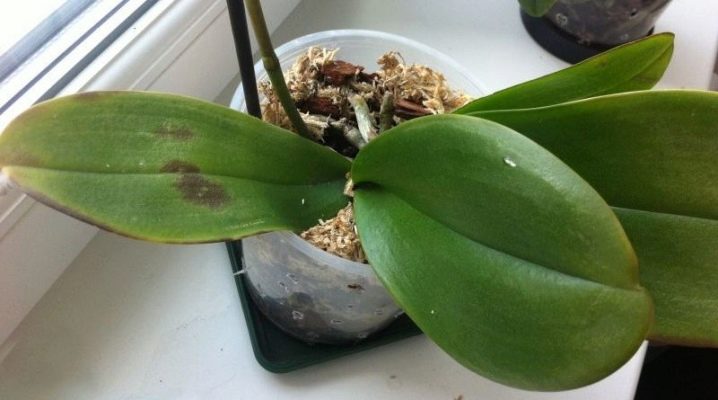
An orchid is a very beautiful but capricious flower that requires constant and competent care. This plant is susceptible to many diseases, among which there are both frivolous and incurable. Very often, strange spots of different colors appear on the leaves of an orchid. Today we will learn about the origin of these lesions and learn how to deal with them.
Why do spots appear?
There are many different types of orchids. This gorgeous flower is taken up by many people who want to decorate their home, but the orchid is capricious in leaving. Without proper treatment, this flower can soon lose its attractive appearance, get sick and even die. Many growers who are fond of orchids have at least once faced the problem of characteristic spots appearing on their foliage. They can vary in color, dry, wet, sticky and even fluffy. Let us consider in more detail what causes the formation of such defects on the leaves.
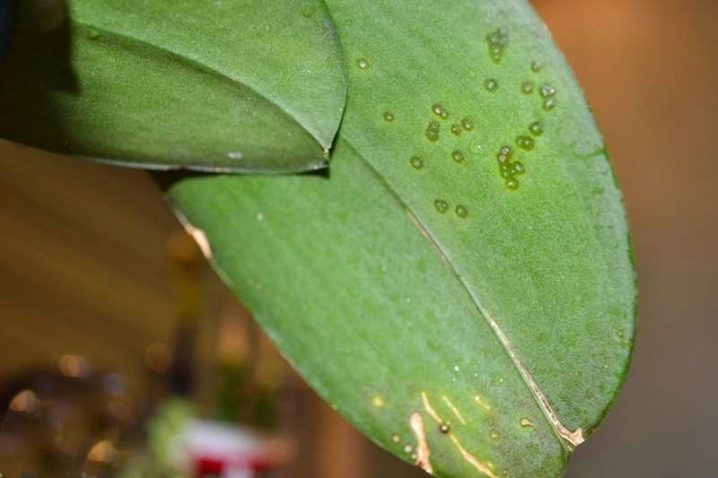
Black
Often black spots appear on the leaves, which indicates that the plant is suffering from a certain disease.
Most often, black spots indicate developing late blight. This disease often affects orchids and is dangerous.
Initially, the spots on the flower have a purple tint, and then darken, becoming black. If you notice such neoplasms, then you should hurry up with treatment, because the flower may die. In most cases, black spots appear due to over-watering the plant.
Black flaws appear on the leaves and in the case of her illness, chlorosis. With this ailment, the foliage first becomes covered with dark spots, and then curls.
A fungal infection can also cause black and yellow spots. The size of the specks can vary. It was at this time that the fungus develops actively inside the tissues of the flower. As a result, he can hit the plate of the leaf, because of which he will die.
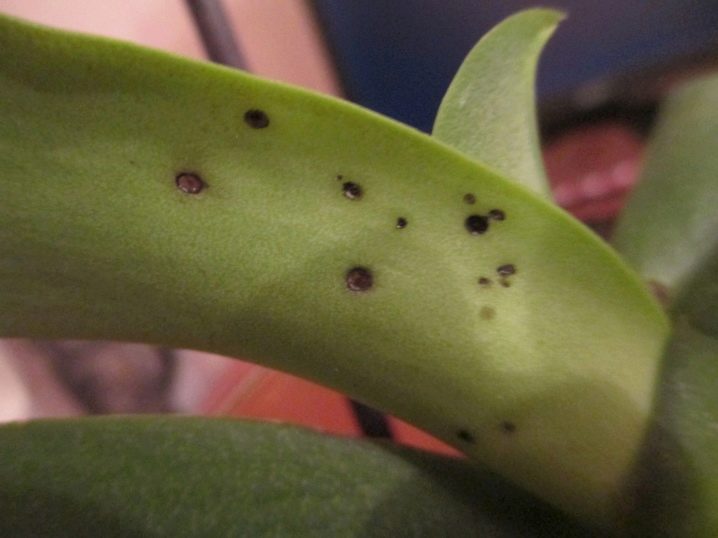
Yellow
Occasionally, noticeable specks of yellow may appear on the leaves of this beautiful flower. Sometimes their formation indicates uncomfortable conditions for keeping the plant, for example, in direct sunlight. Because of this, very often small yellowish dots appear on orchid leaves. To solve this problem, you do not have to use special medicinal compositions - you just need to rearrange the pot with the plant in a place more convenient for it.
Yellow spots can appear on orchid foliage along with black dots. This will indicate that the plant has been attacked by the fungal infection described above.
And also, many growers are faced with the fact that uneven convex yellow spots appear on the leaves of the flower. Subsequently, they seem to push through the infected area of the leaf. The death of flower leaf tissue is not the worst problem that can be solved very quickly and easily. The main thing is to provide the orchid with proper and constant care, use suitable water for irrigation.
Yellow spots also appear due to the development of bacterial diseases. With this ailment, the points have a uniform color. Their size usually reaches about 7 mm. Such a disease appears due to too high temperature conditions and poor ventilation in the room.
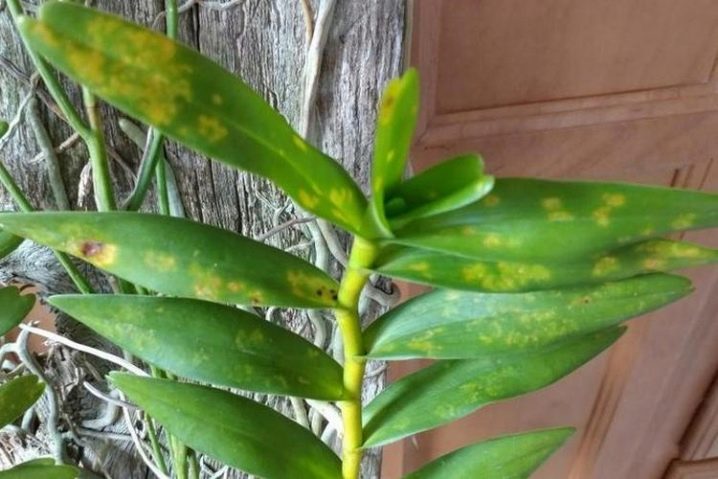
Brown and brown
More serious problems may be indicated by brown and brown spots appearing on the leaves of the orchid. Such defects are both greasy and wet, and dry. So, dry spots often appear due to a too high level of humidity in the room where the flower is located. This ailment should be feared, since the spots will eventually spread further throughout the plant, capturing more and more new areas.
Brown spots on the leaves are also formed due to bacterial rot.
With such problems, defects spread over the entire surface of the plant. It so happens that the orchid leaf is completely covered by such formations. In this case, there is nothing left but to remove the damaged element.
Brown spots appear on orchid leaves if there is a disease such as brown rot. This disease usually affects the roots of the flower, and after them the leaves. At first, small areas fall on the specks, but then the defects cover the entire sheet completely.
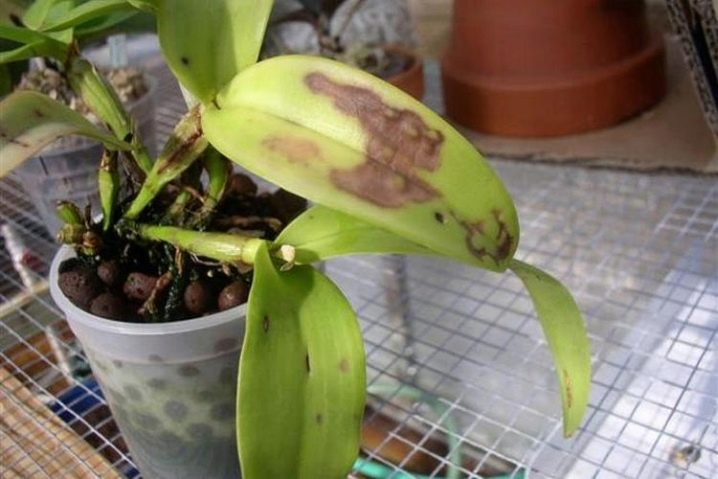
White
One of the most common ailments faced by orchid holders is the white specks that appear on the leaves of the plant. If the leaves of the plant are covered with similar lesions, then this indicates an active bacterial, viral or fungal disease.
There are cases when an almost transparent light or whitish bloom appears on the leaves. Such a defect usually makes itself felt on the lower leaves of the flower. In the future, the spots pass from the leaves to the rhizomes and the stem, because of which the latter dry out, and the plant itself simply dies. This serious disease is called powdery mildew. You need to start fighting it as early as possible. The treatment of such ailments is a difficult and time-consuming process.
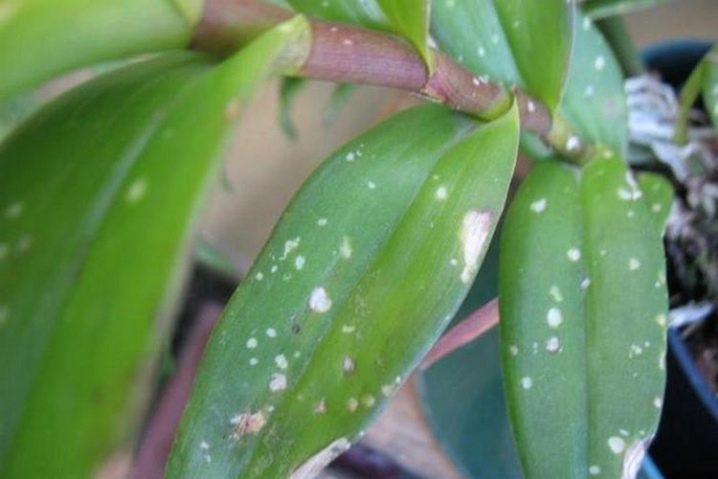
Bright
The spots that appear on the leaves of orchids are usually not very bright. The most striking and noticeable are usually yellow and white blotches that appear for various reasons. However, it also happens that bright red areas appear on the leaf blades of this luxurious flower. These defects can be caused by:
- finding an orchid in direct sunlight, which affects this plant is destructive;
- brown rot;
- anthracnose;
- attack of a spider mite, scale insects.
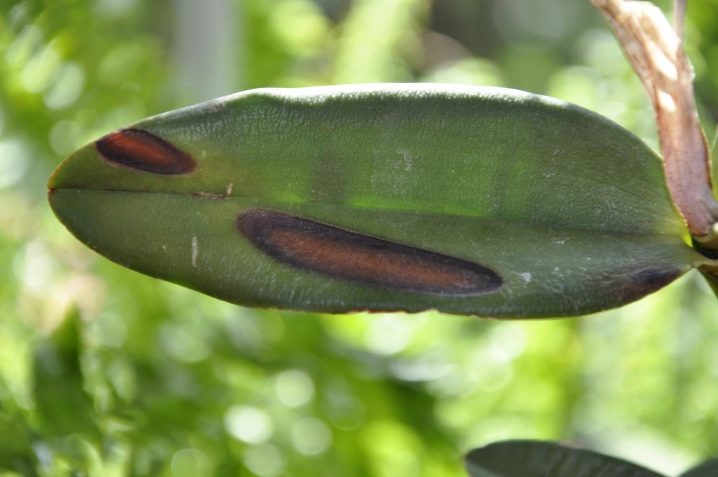
How to treat?
It does not matter at which part of the leaves spots and dots of different colors appeared - they can form on top or on the back of the plate.
In all cases, it is necessary to start treating the flower in time, otherwise it will die. For this, various chemical agents and effective folk methods are used.
Chemicals
Today, in specialized garden stores, you can find many effective and inexpensive chemicals that help protect the orchid from all sorts of misfortunes. You can get rid of specks on the leaves of this flower by using the following popular remedies, tested by many growers:
- Fundazol;
- Fitosporin;
- special fungicidal solutions;
- antibacterial and antiseptic drugs;
- copper preparations;
- Bordeaux mixture;
- oil based product - Promanal;
- "Quadris";
- "Pure color";
- intestinal poisons - "Aktellik", "Aktara", "Nurell-D";
- contact poison - "Fozalon" and many others.
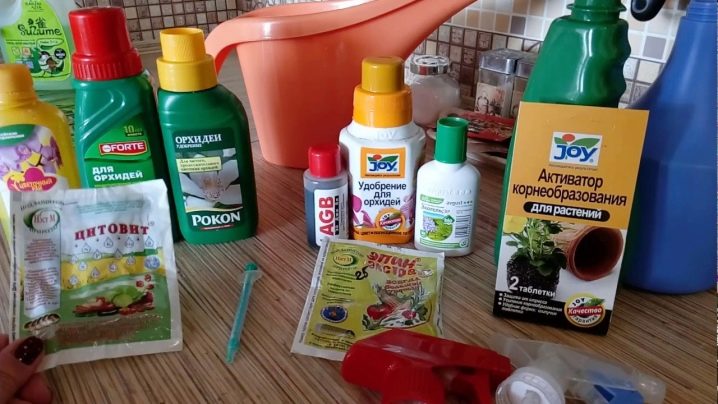
Before using highly effective chemicals for the treatment of orchids, it is very important to read the instructions for their use. Even if you consider yourself an experienced florist, you should not neglect this rule if you do not want to seriously harm the plants and your own health.
If you are a novice florist, then it is advisable to consult about the use of such means with specialists with sufficient experience. This way you can avoid serious mistakes in orchid treatment.
It is necessary to buy all the listed funds (and the like) only in specialized stores, so as not to stumble upon a low-quality product or a fake.
Traditional methods
Not all growers resort to treating orchids with aggressive chemicals. Of course, they demonstrate themselves as very effective, but you need to work with them carefully if you do not want to harm the flower. Many people decide to abandon the use of such funds, preferring alternative methods.
- In many cases, it is enough just to isolate the affected plant and provide it with ideal conditions, for example, to achieve the optimal percentage of humidity in the room.
- It is permissible to process the leaves with cinnamon or activated carbon. Such means are effective when it comes to the appearance of dark spots on the leaves.
- Many growers treat damaged areas on the leaves with iodine. Of course, this method will be effective if the defects have not yet been triggered. If the situation is not easy, then most likely it will not be possible to do without the use of chemicals.
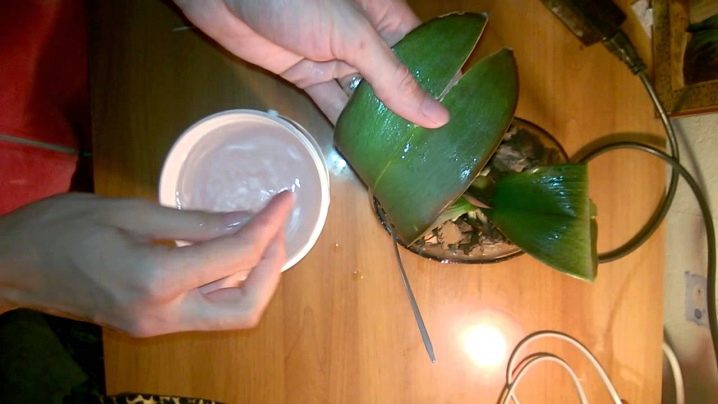
In the arsenal, each grower has its own secrets of fighting orchid diseases, but experts advise you to immediately turn to chemicals and not waste precious time.
Processing rules
Consider the basic rules for processing orchids, if spots appear on it.
- First, the damaged flower must be isolated from the rest of the plants.
- Record the size of the spot formed on the plant.
- Take your time to spray the orchid. Analyze the watering regime you are referring to. Reduce watering if needed.
- If the speck is dry and does not grow further, then you do not need to do anything - watch how it will "behave" further.
- If the stain is wet and growing, then cut it off to a patch of healthy green tissue. Dry the cut off areas and treat with a suitable product. You can use cinnamon, activated angle, or chlorhexidine.
- Treat the flower with phytosporin.
- Treat all tools well. Heat over an open fire.
- Place the flower in a bright place, but not in direct UV light.
- Keep the plant quarantined for a few more weeks.
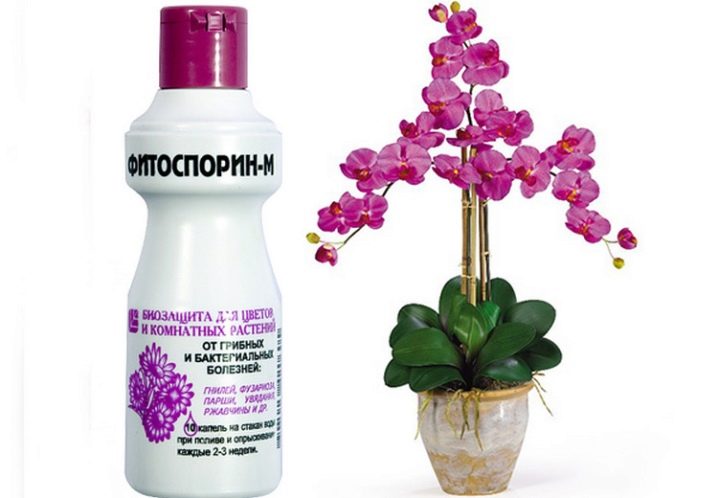
Prevention measures
One should not forget about the necessary preventive measures.
- Provide the plant with proper watering. It will be necessary to moisten the soil again only after 2-3 days, which it will remain dry.
- Take care of the proper air temperature. Daily drops should not exceed 4-5 degrees.
- The plant should be illuminated for 10-12 hours a day. The light should be diffused.
- Fertilize your orchid a couple of times a month.
- Look for good soils that contain tree bark, moss, peat, and river sand. Provide a good drainage layer.
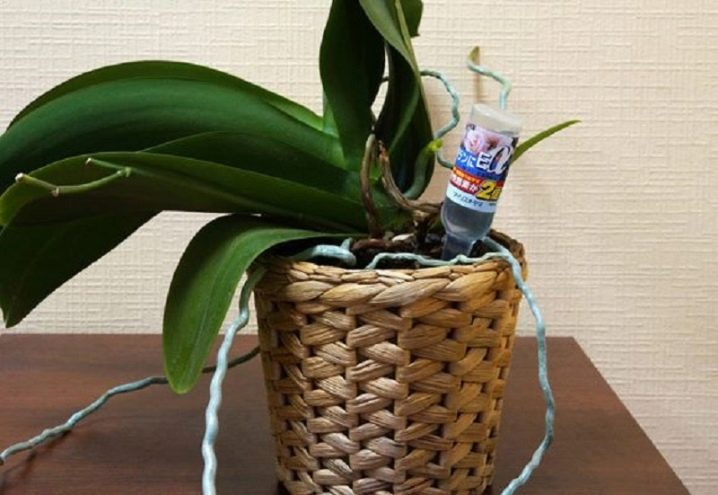































The comment was sent successfully.